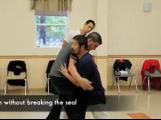Elbow and hand relation must be there. Your elbow twists without moving your hand. You can exercise this by having one person hold your hand and you twist your elbow. Hand don’t move, shoulder don’t move and only rotate the elbow. Once you have a stretch in it, you have Taiji. You pull in with the elbow and your hand simultaneously pushes. To withdraw is to issue. When you are physically able to do this, you have Peng energy. Add this to the form. Once you understand this, you realize that there is a stretch.
A turn is when your waist is not linked to the knee. When you rotate from the Kua and arm pit your movements become deeper.
Example of a honey bottle. If you rotate it and everything moves, nothing happens. When you hold the cap and rotate it, the bottle opens. You need to learn to separate lower and upper body.
Learn yo move from your Kua without moving your knees and chest. Square paper example: at the beginning we move from the center and both kuas move around the center. Eventually you only rotate one Kua and everything else rotates around it. That feels awkward and is not easy to do.
Doing the form as if it is a square helps you reach all four corners to get the correct size of the movements, and after 3 years we then begin paying attention to the inside. A lot of stretching (with the movements) is needed. If you don’t cover the 4 corners, then it becomes what you feel or think, but you don’t have it. In the beginning it is physical. At the end it becomes an intention.
Create the feeling that you are breaking out of something and breaking something while you do your form. Your moves should be powered when you do the form.
Keep the torso straight. Don’t bend your back.
In with elbow and make your body small. Out with hand and make your body very big. Your form at that stage will look akward, but you need to experience this.
Punch to the ground your feet have to be 45 degrees. Half the moves of Yilu are 45 degrees and half are straight line.
When your shoulder and Kua are not open enough, your moves are not smooth.
Don’t raise shoulders. Also, never raise the elbows. You have to learn with a method. The elbow needs to be trapped inside. When you do that at the beginning, you will look hunched. That is ok during the learning stage.
When you ask a question, you need to understand the nature of a question. A question should be phrased as you don’t know what to do. Shifu used as an example the bai hui. You should ask the question accepting you do not know what to do with the bai hui. Do not make assertions or make assumptions. Do not discuss. Do not ask if the bai hui is stretched or a pulled. Ask what am I going to do with the bai hi and listen to Shifu explain. When you locate bai hui, do not do anything with it. It is a reference. Now you find the hui yin and make a vertical stretch with the bai hui. That is it. The first action is a point of reference. What is important is what you do after that. Another example is the positive circle. The first half is a reference. What is important now is the second half. The second half does not go back on the same line. Your first and second half cannot be in the same line. The moves must be opposite. They cannot be the same. Many times we do not understand Shifu when he says we are wrong because you’re moving in the same line.
Hong (Junsheng) taught Shifu to not listen to the students description of the movement. Hong taught Shifu to demonstrate the correct move. You lead the whole class into a vicious cycle when you ask you a question by making assumptions and discussions. Ask accepting you do not know and listen to Shifu’s explanation.
In King Kong nailed fist on the fifth move lock your chest. If you move your chest you are doing nothing. Lock it when turning and stepping forward.


